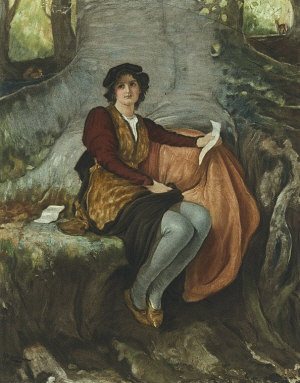 Title page from Shakespeare's First Folio | Several libraries have a scanned copy of Shakespeare's first publication of a collection of his work also known as the First Folio published in 1623. The Miami University, University of Victoria, and the University of Pennsylvania all have posted a copy. The Victoria website even allows you to compare more than one copy of First Folio to each other. The Brandeis First Folio versus the New South Wales First Folio. This can be interesting to some because then when a printer found a mistake while printing, he |
| corrected the error so the books after that would have the correction but the ones with the error would be sold as part of the original run (So a run of 1,000 may have a number corrections incorporated into the run). So you can see how early in the run the book was by how many errors it still had. When you look at the first folio, the words look different but actually they aren't. It's just a case of understanding the spelling |  Rosalind in "Shakespeare Illustrated" by Robert Walker Macbeth, 1888 |
 A snippet from "As you Like it". (Right click on it and select "view image" to see it larger.) Take a look at the spellings. At the end of the first line, "loue" is actually "love." On the third line, "ƒhall we part ƒweet girle?" is pronounced "Shall we part sweet girl?" On the eigth line, "griefes your ƒelfe" is "griefs your self". It doesn't take long to adjust once you get used to it and soon it's fairly easy to read it with the right pronunciation. | conventions at the time. "V" was used for the "U" in print. So "us" becomes "vs". If they ran out of a "w" they would use 2 v's as "vv". The "S" can be either an "S" or an elongated "s" which looks like an "ƒ" with a truncated dash. The elongated "s" used to be quite common but disappeared in newspapers in the early 1800s according to Nathan Redshield. Even today, some Shakespearean actors like seeing the original text because it tells them how a word is meant to be pronounced as Ian Thal explained in his blog, |
 Shakespeare, stained glass, 1903. Carnegie Library,Vancouver BC photographed by Patrick Burns | There are a few tutorials on the first folio on the internet. Gregory Doran, Chief Associate Artistic Director, Royal Shakespeare Company, gives a talk on video at http://www.rscshakespeare.co.uk/first_movies.html. UPenn gives multimedia slide presentations on different aspects of the first folio at http://dewey.library.upenn.edu/sceti/furness/eric/teach/index.cfm. Reading, speaking and enjoying Shakespeare is a powerpoint on pronunciation, language and acting in Elizabethan England for teens. It does a few definitions but makes a nice simple intro. |
Resources
Royal Shakespeare Company
The First Folio of Shakespeare: The Norton Facsimile by William Shakespeare, Charlton Hinman ed. The review by Amazon makes this book sound very cool so I am including it. "Charlton Hinman's facsimile of Shakespeare's First Folio was a colossal achievement when it was first published in 1968, and its reputation is further enhanced by this beautiful second edition. Looking for a way to provide scholars with a reliable version of Shakespeare's text, Hinman invented a device that sped up the collation process, allowing him to compare 82 of the surviving copies of the Folio and bring to light features of Shakespeare's work that have been--and continue to be--edited out of most modern editions. A Midsummer Night's Dream, for example, contains what are known as false starts, fragments of earlier versions of certain speeches. These traces of the composition process survive only because the printers, working directly from Shakespeare's handwritten copy, were not given a chance to thoroughly proofread their work. Though they would make crucial changes during the printing process, it was too wasteful to throw away pages that were already printed. Thus, when they went to bind the Folios, each book contained a fascinating patchwork of corrected and uncorrected copy."
"Also hidden beneath the familiar text of the plays is a portrait of the printers who created the book. Their names remain unknown, but Professor Hinman was able to track individuals' work by examining their spelling habits. Their story is as important to this book as the works of literature that it contains. The many errors the printers introduced into the text of Shakespeare's work still provide fertile ground for theatrical and academic debate. Hamlet, for example, wishes that his "too, too solid flesh would melt."--or is it his "sullied" flesh, or perhaps his "sallied" flesh? Which is Shakespeare, and which is an error? We cannot blame the printers; they spent long hours setting page after page of tiny type, working in a cramped space that smelled strongly of the stale urine they used to soften the inking pads. It is ironic that the most revered symbol of English high culture owes its existence--in part, at least--to the productive bladders of a handful of pressmen. This book gives these men their due, demonstrating the extent to which Shakespeare's plays were the work not just of one man but of a whole society. "
Applause First Folio of Shakespeare in Modern TypeComedies, Histories and Tragedies, 2000.
The First Folio of Shakespeare 1623 by William Shakespeare, Doug Moston, 1995.
The Book of William: How Shakespeare's First Folio Conquered the WorldPaul Collins, 2009.
No comments:
Post a Comment